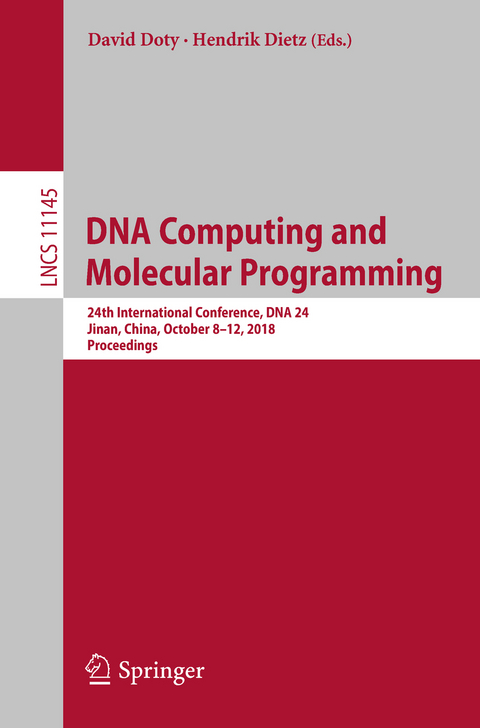
DNA Computing and Molecular Programming
Springer International Publishing (Verlag)
9783030000295 (ISBN)
This book constitutes the refereed proceedings of the 24th International Conference on DNA Computing and Molecular Programming, DNA 24, held in Jinan, China, in October 2018.
The 12 full papers presented were carefully selected from 14 submissions. Research in DNA computing aims to draw together mathematics, computer science, physics, chemistry, biology, and nanotechnology to address the analysis, design, and synthesis of information-based molecular systems. The papers were sought in all areas related to biomolecular computing, including: algorithms and models for computation on biomolecular systems; computational processes in vitro and in vivo; molecular switches, gates, devices, and circuits; molecular folding and self-assembly of nanostructures; analysis and theoretical models of laboratory techniques; molecular motors and molecular robotics; information storage; studies of fault tolerance and error correction; software tools for analysis, simulation, and design; synthetic biology and in vitro evolution; and applications in engineering, physics, chemistry, biology, and medicine.
CRN++: Molecular Programming Language.- Know When to Fold 'Em: Self-Assembly of Shapes by Folding in Oritatami.- Optimizing Tile Set Size while Preserving Proofreading with a DANN Self-Assembly Compiler.- A Content-Addressable DNA Database with Learned Sequence Encodings.- Temporal DNA barcodes: A time-based approach for single-molecule imaging.- Hierarchical Growth is Necessary and (Sometimes) Sufficient to Self-Assemble Discrete Self-Similar Fractals.- Self-Assembly of 3-D Structures Using 2-D Folding Tiles.- Forming Tile Shapes with Simple Robots.- Transcript Design Problem of Oritatami Systems.- Freezing Simulates Non-freezing Tile Automata.- Construction of Geometric Structure by Oritatami System.- A reaction network scheme which implements the EM algorithm.
| Erscheinungsdatum | 09.09.2018 |
|---|---|
| Reihe/Serie | Lecture Notes in Computer Science | Theoretical Computer Science and General Issues |
| Zusatzinfo | XIV, 209 p. 106 illus. |
| Verlagsort | Cham |
| Sprache | englisch |
| Maße | 155 x 235 mm |
| Gewicht | 349 g |
| Themenwelt | Informatik ► Software Entwicklung ► User Interfaces (HCI) |
| Mathematik / Informatik ► Informatik ► Theorie / Studium | |
| Schlagworte | Artificial Intelligence • Automata Theory • Bioinformatics • Cellular Automata • communication channels (information theory) • content-based image retrieval • content-based retrieval • Finite Automata • Hardware • Image Processing • Image Quality • Image Segmentation • Information Retrieval • multiple robot • optical resolving power • query images • Robotics • Robot Learning • Semantics • Super-resolution |
| ISBN-13 | 9783030000295 / 9783030000295 |
| Zustand | Neuware |
| Informationen gemäß Produktsicherheitsverordnung (GPSR) | |
| Haben Sie eine Frage zum Produkt? |
aus dem Bereich


